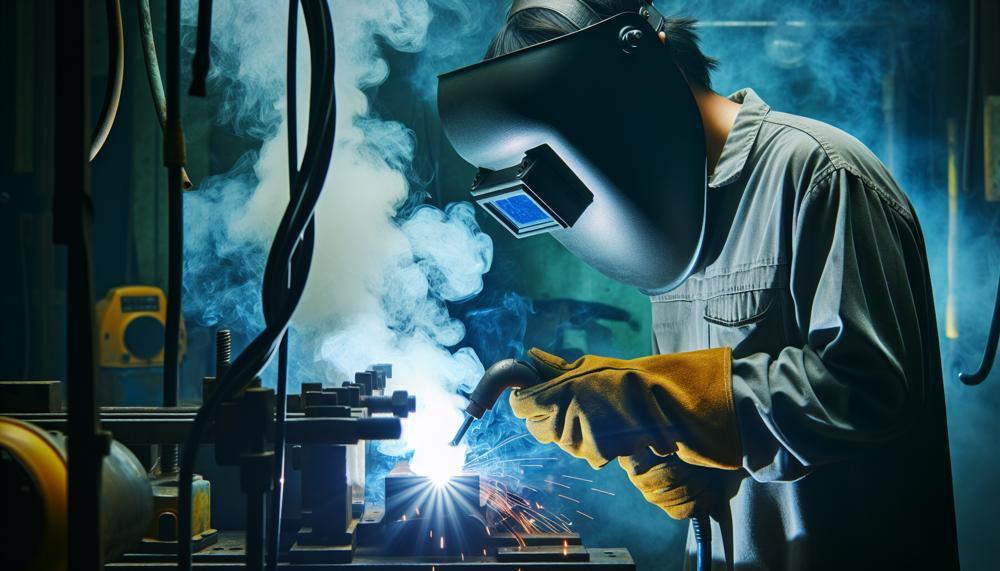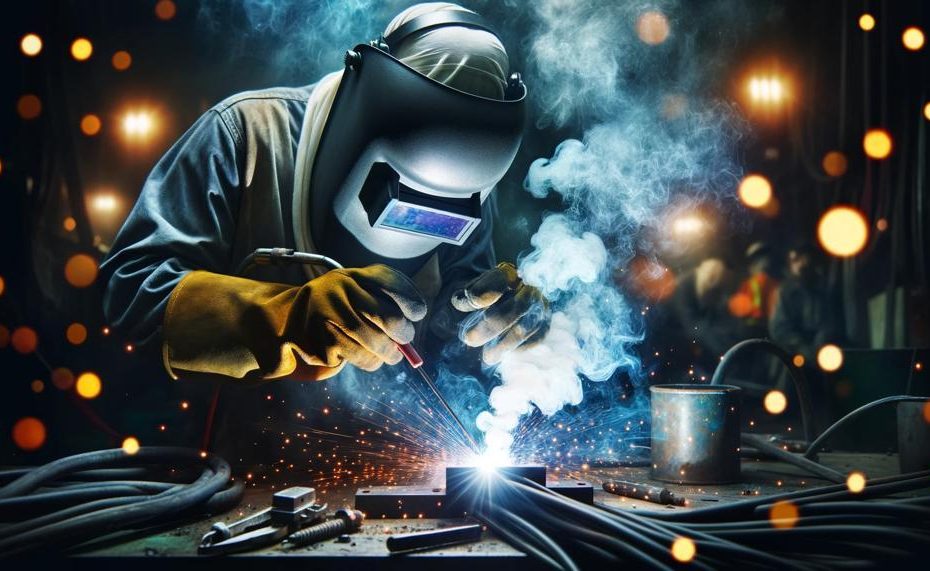As a welder, you’re no stranger to the hot sparks and bright flashes of welding processes. But what about the invisible danger that comes with it? That’s right, we’re talking about welding fumes – those pesky particles that you inhale while on the job. And while they may seem harmless, the truth is, they can pose serious health risks if not properly managed.
So before you pick up your welding torch, let’s take a moment to discuss the safety of breathing welding fumes. Because when it comes to your health, ignorance is definitely not bliss.

So, is it safe to breathe welding fumes?
No, it is not safe to breathe welding fumes. Welding fumes can contain toxic ingredients, including:
- Metal working fluids
- Oils
- Rust inhibitors
- Zinc
- Cadmium plating
- Chromates
- Paints and solvents
- Lead oxide primer paints
- Plastic coatings
Contents
- 1 Is It Safe To Breathe Welding Fumes?
- 2 The Dangers of Inhaling Welding Fumes: Short-Term and Long-Term Health Effects
- 3 Chemicals Found in Welding Fumes: Manganese, Chromium, Nickel, and Cadmium
- 4 Different Types of Welding Processes and Their Specific Hazards
- 5 Regulations and Safety Measures for Welding Fumes: OSHA’s Permissible Exposure Limits (PELs)
- 6 Engineering Controls to Minimize Exposure to Welding Fumes
- 7 Personal Protective Equipment (PPE) for Workers Handling Welding Materials
- 8 Conclusion
Is It Safe To Breathe Welding Fumes?
| Is It Safe To Breathe Welding Fumes? | |
| Health Risks Associated With Welding Fumes | |
| Potential Consequences | |
| When working in the welding industry, it is crucial to understand the potential health risks associated with breathing in welding fumes. These risks can have both short-term and long-term effects on the body, ranging from minor irritations to severe, life-threatening conditions. | |
| Lung Damage | Exposure to welding fumes can lead to lung damage and respiratory illnesses such as bronchitis and pulmonary edema. These conditions can have a significant impact on an individual’s quality of life, making it difficult to breathe and perform daily tasks. |
| Cancer | Inhaling welding fumes has been linked to various types of cancer, including lung, larynx, and urinary tract cancers. These types of cancer can be debilitating and even life-threatening. |
| Metal Fume Fever | Breathing in certain chemicals found in welding fumes can cause metal fume fever, which is characterized by flu-like symptoms such as fever, chills, and nausea. This condition may seem minor, but it can significantly impact an individual’s ability to work and perform daily tasks. |
| Stomach Ulcers | Welding fumes can contain substances that irritate the lining of the stomach and lead to stomach ulcers. These ulcers can be painful and may require medical treatment. |
| Kidney Damage | Chronic exposure to welding fumes can cause kidney damage and affect the function of the kidneys. This can lead to a range of health issues and may require medical intervention. |
| Nervous System Damage | Inhaling welding fumes can also damage the nervous system, leading to tremors, emotional problems, and hearing and vision loss. This can significantly impact an individual’s overall well-being and quality of life. |
| Parkinson’s-like Symptoms | Exposure to manganese in welding fumes has been linked to Parkinson’s-like symptoms, such as tremors and difficulty with movement. These symptoms can have a significant impact on an individual’s daily life and may require medical treatment. |
The Dangers of Inhaling Welding Fumes: Short-Term and Long-Term Health Effects
The dangers of inhaling welding fumes can have grave consequences for an individual’s physical well-being, both in the short-term and long-term. In the immediate aftermath, exposure to welding fumes can result in Metal Fume Fever, a condition that exhibits symptoms similar to those of the common flu and lasts approximately 24 hours.
These symptoms include fever, chills, body aches, and nausea. However, the prolonged effects of inhaling welding fumes are much more worrisome.
One of the most severe long-term effects is Chronic Obstructive Pulmonary Disease (COPD). Welders who consistently come into contact with welding fumes are at a higher risk of developing this debilitating lung disease. COPD is characterized by breathing difficulties, coughing, and wheezing, making it challenging for individuals to carry out daily tasks. In severe cases, it can even lead to disability or premature death.
Furthermore, exposure to welding fumes can also lead to other life-threatening health issues, including lung damage, cancer, stomach ulcers, kidney damage, nervous system damage, and symptoms resembling Parkinson’s disease. The specific components of welding materials that contribute to these health problems include chromium, nickel, beryllium, cadmium, and manganese.
To safeguard welders from these hazards, it is crucial for employers to implement safety protocols. This includes providing adequate ventilation systems or respiratory protection and regularly monitoring exposure levels. The most effective means of controlling welding fume exposure is through local exhaust ventilation systems that capture fumes at the source.
In essence, inhaling welding fumes can have both short-term and long-term health repercussions for individuals. It is imperative for employers to take necessary precautions to safeguard their workers from these risks.
Chemicals Found in Welding Fumes: Manganese, Chromium, Nickel, and Cadmium
Welding is a common practice in the construction and manufacturing industries, but it comes with its own set of health hazards. Exposure to welding fumes containing manganese, chromium, nickel, and cadmium can lead to serious health risks for workers.
These substances can cause neurological disorders, respiratory problems, skin irritation, and even cancer. To better understand these potential health risks, let’s take a closer look at each substance individually.
Manganese:
Manganese is an essential element in our bodies and is required for proper brain function. However, excessive exposure to manganese in welding fumes can lead to neurological disorders such as Parkinson’s disease. This is because the body cannot effectively remove excess manganese, leading to a build-up in the brain. Welders who are exposed to high levels of manganese may experience symptoms such as tremors, difficulty walking, and memory loss.
It is crucial for employers to provide proper ventilation and respiratory protection to minimize exposure to this hazardous substance.
Chromium:
Chromium is another hazardous substance found in welding fumes. Exposure to chromium can lead to respiratory problems such as asthma and lung cancer. In addition, prolonged exposure to chromium can also cause skin irritation and damage to the digestive system.
To prevent these health risks, it is important for employers to implement safety measures such as using local exhaust ventilation systems and providing workers with protective gear.
Nickel:
Nickel is commonly used in stainless steel alloys and is released into the air during the welding process. Exposure to nickel in welding fumes can cause skin allergies and respiratory problems. Prolonged exposure to high levels of nickel has also been linked to an increased risk of lung cancer.
To protect workers from these health hazards, employers should prioritize proper ventilation and provide workers with respiratory protection equipment.
Cadmium:
Cadmium is a heavy metal that can be found in some welding electrodes and filler materials. When inhaled, cadmium can cause severe lung damage and even lead to kidney failure. It has also been classified as a human carcinogen by the International Agency for Research on Cancer (IARC).
To prevent exposure to this hazardous substance, employers should use alternative materials and ensure proper ventilation is in place.
Different Types of Welding Processes and Their Specific Hazards
Welding is a crucial process in many industries, but it also poses various hazards to workers. Exposure to welding fumes, in particular, can have severe health consequences. Here are the specific hazards associated with different types of welding processes:
- Inhaling Toxic Fumes: The fumes produced during welding contain harmful substances such as metals (chromium, nickel, manganese), gases (carbon monoxide, nitrogen oxides), and volatile organic compounds (benzene, formaldehyde). These fumes can cause respiratory irritation, breathing problems, and even long-term health risks like lung cancer.
- Electrocution: Certain welding processes, like arc welding and resistance welding, use high electrical currents that can be dangerous if safety precautions are not followed.
- Thermal Burns: The high temperatures used in welding processes can cause burns if workers come into contact with hot materials or sparks.
- Eye Injuries: The intense light produced during welding can cause eye injuries if proper eye protection is not worn. This can lead to conditions like flash burns, cataracts, and retinal damage.
- Fire and Explosion Hazards: Welding involves highly flammable gases and materials, which can cause fires or explosions if proper safety measures are not taken.
The safety of breathing in welding fumes is a significant concern for workers. Exposure to these fumes can result in immediate and long-term health effects, such as respiratory irritation and lung cancer. Prolonged exposure to welding fumes can also lead to chronic conditions like asthma and bronchitis.
Therefore, it is crucial to implement control measures to reduce the risk of exposure to these hazards. These measures include:
- Ventilation Systems: Adequate ventilation is essential in controlling the concentration of welding fumes in the air. Local exhaust systems can effectively capture and remove fumes at the source.
- Personal Protective Equipment (PPE): Workers should wear appropriate PPE, including respirators, to protect themselves from inhaling welding fumes.
- Coating Removal: Before welding, it is crucial to remove any coatings or paints on the materials to prevent the release of toxic fumes.
- Proper Training: Workers must receive proper training on the potential hazards of welding processes and how to use control measures effectively.
- Air Monitoring: Employers should regularly monitor the air quality in the work area to ensure compliance with PELs (permissible exposure limits) and take necessary measures if the levels exceed the limits.
Regulations and Safety Measures for Welding Fumes: OSHA’s Permissible Exposure Limits (PELs)
OSHA’s Permissible Exposure Limits (PELs) are regulations that establish the maximum amount of hazardous substances, including welding fumes, that employees can be exposed to while on the job. These standards are determined through thorough scientific research and recommendations from reputable organizations like NIOSH. To guarantee the safety of workers, these limits are consistently evaluated and revised. Through careful monitoring and management of exposure levels, employers can effectively prevent overexposure and safeguard their employees from the detrimental impact of welding fumes.
Welding is a crucial process in many industries, but it also presents significant risks to worker health and safety due to exposure to toxic fumes. These fumes can cause a variety of health problems, ranging from short-term irritations to long-term respiratory issues. As a result, OSHA has established PELs as a protective measure for workers.
For instance, let’s say you work in construction and have been assigned to weld some metal beams for a new building. The welding process produces hazardous fumes that can be harmful if inhaled in large quantities. However, by adhering to OSHA’s PELs and monitoring your exposure levels, you can effectively protect yourself from overexposure and minimize the risk of adverse health effects. This regulation ensures that employers prioritize the safety and well-being of their workers by implementing proper safety measures.
Engineering Controls to Minimize Exposure to Welding Fumes
Effective engineering controls play a critical role in reducing exposure to welding fumes and promoting safe breathing practices. These measures are essential to maintain a healthy work environment and ensure the safety of workers. Some of the most effective engineering controls that can be implemented include the use of ventilation systems, substitution, and personal protective equipment (PPE).
Ventilation systems are designed to remove or minimize the release of hazardous fumes into the air. These systems help to keep the air clean and free from harmful substances, ensuring that workers are not exposed to them. Additionally, substitution involves replacing toxic materials with less harmful ones, which can significantly reduce the risk of exposure to welding fumes.
In addition to these measures, using personal protective equipment (PPE) is crucial in providing a physical barrier against fumes. PPE includes items such as respirators, helmets, and gloves, which are specifically designed to protect workers from inhaling welding fumes. Proper training and education on safe welding practices are also essential in preventing exposure to welding fumes. This includes educating workers on how to properly use ventilation systems and PPE, as well as promoting safe welding techniques.
It is important to regularly review and update these engineering controls to ensure they continue to effectively minimize exposure to welding fumes. By implementing these measures and providing proper training and education, employers can create a safe work environment for their employees while also promoting positive health practices.
Personal Protective Equipment (PPE) for Workers Handling Welding Materials
In order to safeguard themselves from the hazardous welding fumes, workers handling welding materials must make use of Personal Protective Equipment (PPE). It is important to note that PPE should be used in combination with other engineering controls to minimize exposure to welding fumes and promote safe breathing practices. Here are some of the different types of PPE that workers should utilize:
- Welding helmet: An essential piece of PPE, the welding helmet protects the face, eyes, and neck from ultraviolet light, flash burns, infrared light, sparks, and heat. The selection of the appropriate shade level for the helmet should be based on the welding process and materials being used.
- Face shield: To provide additional protection to the face and neck from flying debris and sparks, a face shield should be worn along with a welding helmet.
- Safety glasses (goggles): To protect their eyes from potential hazards, workers should wear safety glasses or goggles under the welding helmet.
- Gloves (leather): While handling welding materials, leather gloves offer protection against burns and cuts. It is crucial to choose well-fitting gloves that are specifically designed for welding.
- Earplugs: The loud noises produced during welding can damage hearing over time, which is why it is important for workers to wear earplugs to safeguard their ears from excessive noise.
- Welding cap: For added protection against sparks and heat, a welding cap can be worn to cover the head and neck.
Conclusion
In conclusion, the safety of breathing welding fumes cannot be underestimated. While the bright flashes and hot sparks may seem like the most obvious hazards in welding, there is an invisible danger that comes with it – welding fumes. These particles contain toxic substances such as chromium, nickel, and manganese that can have serious health consequences if not properly managed.
Short-term exposure to welding fumes can cause symptoms like dizziness, nausea, and eye irritation. However, prolonged exposure can lead to more severe health issues such as asthma and even lung cancer. It is crucial for welders to prioritize their safety by taking necessary precautions before starting any job. This includes ensuring proper ventilation and wearing personal protective equipment (PPE).
Employers also have a responsibility to provide a safe working environment by implementing safety protocols and regularly monitoring air quality. Regular medical check-ups are essential for early detection of any potential health effects from welding fumes.
Breathing in welding fumes is not worth risking your health. So before you pick up your welding torch again, make sure you prioritize your safety and take all necessary precautions.
Remember, ignorance is not bliss when it comes to your well-being.





